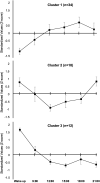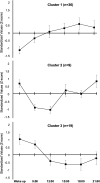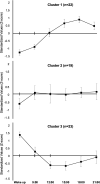Can the Assessment of the Circadian Rhythm of Pain Be Shortened? A Study of Community-Dwelling Participants with Chronic Pain
- PMID: 38812822
- PMCID: PMC11135561
- DOI: 10.2147/JPR.S452790
Can the Assessment of the Circadian Rhythm of Pain Be Shortened? A Study of Community-Dwelling Participants with Chronic Pain
Abstract
Purpose: This study aimed to juxtapose the circadian rhythm of pain with the conventional 7-day assessment and ascertain the feasibility of condensing the evaluation of the circadian rhythm of pain into a 3-day timeframe.
Patients and methods: Seventy-three patients with pain persisting for a minimum of 3 months and a numerical rating scale (NRS) score of ≥2 were recruited from three medical centers. The circadian patterns of pain were appraised over a 7-day period by quantifying the intensity of pain at six temporal junctures each day using a 10-cm visual analog scale (VAS). Cluster analysis was performed using six standardized variables derived from the VAS score of each participant at six designated time points to identify cohorts with analogous circadian rhythms of pain. The clusters were discerned for the 7- and 3-day assessments (Tuesday-Thursday, Friday-Sunday, and Sunday-Tuesday), according to the research objectives. Cohen's kappa coefficient was calculated to gauge the intra-observer variability to assess the consistency between the outcomes of the cluster analysis for the 7-day assessment and each of the 3-day assessments.
Results: The highest Cohen's kappa coefficient was observed for the 3-day evaluation spanning from Friday to Sunday, indicating a substantial concordance with the results of the 7-day assessment.
Conclusion: Our results suggest that it may be prudent to consider implementing a condensed 3-day evaluation of the circadian rhythm of pain that is tailored to individual characteristics. This approach will allow a better understanding of the diurnal rhythms of chronic pain in patients and implement more targeted and specific pain management strategies. Furthermore, it will contribute to increased patient satisfaction through early intervention.
Keywords: chronic pain; circadian rhythm; pain; physical activity.
© 2024 Tanaka et al.
Conflict of interest statement
The authors report no conflicts of interest in this work.
Figures




Similar articles
-
Classification of circadian pain rhythms and pain characteristics in chronic pain patients: An observational study.Medicine (Baltimore). 2021 Jun 25;100(25):e26500. doi: 10.1097/MD.0000000000026500. Medicine (Baltimore). 2021. PMID: 34160466 Free PMC article.
-
[Assessment of circadian rhythm in pain and stiffness in rheumatic diseases according the EMA (Ecologic Momentary Assessment) method: patient compliance with an electronic diary].Reumatismo. 2005 Dec;57(4):238-49. doi: 10.4081/reumatismo.2005.238. Reumatismo. 2005. PMID: 16380750 Italian.
-
Is there a 24-hour rhythm in alcohol craving and does it vary by sleep/circadian timing?Chronobiol Int. 2021 Jan;38(1):109-121. doi: 10.1080/07420528.2020.1838532. Epub 2020 Nov 9. Chronobiol Int. 2021. PMID: 33167734 Free PMC article.
-
Circadian rhythms and pain.Neurosci Biobehav Rev. 2021 Oct;129:296-306. doi: 10.1016/j.neubiorev.2021.08.004. Epub 2021 Aug 8. Neurosci Biobehav Rev. 2021. PMID: 34375675 Free PMC article. Review.
-
Circadian variation in sports performance.Sports Med. 1996 Apr;21(4):292-312. doi: 10.2165/00007256-199621040-00005. Sports Med. 1996. PMID: 8726347 Review.
References
-
- Markenson JA. Mechanisms of chronic pain. Ame J Med. 1996;101:1. - PubMed
LinkOut - more resources
Full Text Sources

